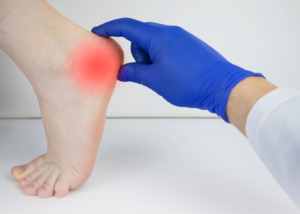Our team at Sole Motion sees a range of new patients every week with pain at the back of their heel, usually on just one foot. While some of these patients are active runners, cross-fitters, dancers and weekend warriors for their sports team, others are office workers who rack up few kilometres aside from their weekend outings and morning dog walks.
Regardless of the level of activity, most of our consultations start with the Achilles tendon as the prime suspect for pain at the back of the heel. While many times we confirm this diagnosis, other times we don’t, going on to uncover a different underlying cause that requires a different treatment approach to help get the best results.
Given our experience and knowledge in this area, today we thought we’d share about the other causes of heel pain we see in adults, as well as what Achilles tendon pain really looks and feels like.
Achilles Tendinopathy: The Low Down
Your Achilles tendon is the strongest and largest tendon in your body. It is the tendon connected to your calf muscles, and also attaches to the back of the heel bone. Your Achilles tendon is crucial for your ability to walk and run – taking on forces of up to twelve times your body weight during jumping. As such, the Achilles tendon can be injured when it is overloaded and strained during these movements, making it most often an ‘overuse’ activity.
What many people don’t know about the Achilles tendon is that compared to other tendons, it is notably slower and more difficult to heal as it has fewer vessels to bring blood to the area, and a good blood supply brings oxygen and nutrients for optimal repair. This is one of the reasons that we see so many longstanding Achilles injuries in our clinic, paired with not taking (and often not knowing) the right steps to best care for the tendon.
What are the signs that my pain is from my Achilles tendon?
One of the biggest signs is that you experience pain in the cord-like Achilles tendon at the back of your heel when it is palpated, and when you perform movements that engage the tendon such as standing on your toes, or running. You may also experience:
- A lump in the midportion of the tendon: if your Achilles tendinopathy is affecting the midportion of the tendon, you may notice an obvious, palpable lump.
- Swelling or redness over the tendon
- Pain that is exacerbated when you walk uphill
- Stiff tendon and ankles: many people experience some degree of stiffness around the back of their ankle first thing in the morning. The stiffness tends to ease up after a few minutes of walking, but depending on the level of injury, may last longer.
- Variable pain: alongside exercise-induced Achilles pain, others experience Achilles pain when resting, even if they did not feel anything during their exercise.
- Pain that stops you in your tracks when running
- Difficulty standing up on the toes
- Difficulty bearing weight on the affected foot or ankle
What Else Causes Pain At The Back Of The Heel?
As part of your assessment with our Sole Motion team, we not only look for the clinical signs that you have a certain condition, but we also prioritise ruling out the presence of other conditions that can present in the same area. To us, this is a crucial part of providing you with the very best care, as many conditions can share similar symptoms and so can be misdiagnosed. Additionally, at times, an injury can result in multiple problems presenting simultaneously – such as having both damage to your Achilles tendon and bursitis.
If you are currently getting care for pain at the back of your heel and despite following the instructions very carefully, you are not experiencing a change in your pain levels or comfort, or your results are not progressing in the way you would have expected, we invite you to come get a second opinion with us.
Bursitis
Bursitis simply means the inflammation of a bursa, and a bursa is a small, fluid filled sac that sits between structures in the body to help prevent painful friction and rubbing, while promoting lubrication and healthy movement. When the bursa is overloaded, like from excess pressure from tendons or other structures, it can become swollen and painful. This is known as bursitis.We have bursae all around our body, and there are two that sit at the back of the heel that can produce pain:
- The retrocalcaneal bursa: sits between the Achilles tendon and the heel bone. Compressing the bursa will produce painful symptoms that can appear similar to Achilles pain
- The superficial calcaneal bursa: sits just beneath the skin, at the back of the heel where the Achilles tendon inserts. Damage to this bursa can produce pain if you pinch the skin over the heel bone, and may be aggravated by firm heel counters at the back of the shoes that add pressure to this area
Calcaneal Stress Fracture
A stress fracture is a type of bone fracture that occurs gradually over time, starting as tiny, asymptomatic micro-cracks in the bone that grow and worsen to become painful and limit daily activities. A calcaneal stress fracture can occur at the back of the heel by the Achilles tendon, presenting with very similar symptoms to Achilles tendon pain. At your appointment with us, our team will carefully palpate the Achilles tendon to best understand its involvement, and then examine the calcaneus and what it responds to. Stress fractures require immediate and significant care, as without it, the fracture can continue to worsen and cause you more pain.
Heel Pad Syndrome
We all have fat pads at the bottoms of our heels that play an important role in helping us absorb the pressure, shock and weight from every step we take. Whether it occurs naturally with age, or as a result of an injury or medical condition, our heel pads can wear down and no longer support and cushion our heels effectively. In this case, pain starts, often in the middle of the heel, but can also radiate up the back of the heel and mimic some of the symptoms of Achilles pain.
Posterior Ankle Impingement
A posterior ankle impingement is felt when the forefoot and toes are pointed down, which narrows the space at the back of the ankle and can impinge the structures there – often an accessory bone. The cause of the impingement will need to be identified with imaging studies so that the best treatment plan can be created.
Haglund’s Deformity
A Haglund’s deformity is worth mentioning here, though it is usually asymptomatic on its own. A Haglund’s deformity is a bony enlargement (bump) that develops at the back of the heel bone. It leads to pain at the back of the heel because, as it grows, its presence can interfere with the natural movement and positioning of both the Achilles tendon and the retrocalcaneal bursa, causing irritation and pain.
Sever’s Disease
Finally, we thought we’d quickly mention Sever’s disease, a type of growing pain that only presents in children. Sever’s disease occurs when the growth plate at the back of the heel is irritated, most often from tension from the Achilles tendon. The result is pain at the back of the heel. Again, as Sever’s has a different course of treatment than Achilles tendinopathy, getting the right diagnosis is essential to getting the best treatment outcomes.
How Can I Find Out What Is Causing My Heel Pain?
Unfortunately, there’s nothing online that can accurately diagnose the cause of a person’s heel pain (otherwise we’d offer it!) because every person’s circumstances, medical and injury history, lifestyle factors and more, are unique, and must be assessed on a case-by-case basis. When this doesn’t happen is when we see people being treated for weeks or months for the wrong condition, wasting their time, money – and their physical and mental wellbeing.
The Sole Motion team will perform a comprehensive assessment, explain exactly what we’re seeing and what it means (including showing you your video gait analysis), and then design a customised treatment plan to help you get the best results.
Book your appointment with us online here, or by calling 1300 FX FEET





